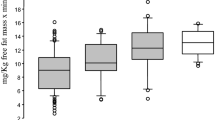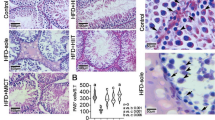Abstract
Thiazolidinediones work by sensitizing the action of insulin by acting as ligands for the PPAR receptor. This study describes the effects of chronic treatment with new benzylidene-thiazolidine-2,4-dione (LPSF/GQ-06) on Leydig cell steroidogenic capacity, and expression of the steroidogenic acute regulatory protein (StAR) and cholesterol side-chain cleavage enzyme (P450scc) in normal rats. Twelve adult male Wistar rats were treated with LPSF/GQ-06 (5 mg/kg) administered by gavage for 15 days. Testosterone in plasma and incubation medium was measured by radioimmunoassay. The StAR and P450scc expression was detected by immunocytochemistry. The levels of total circulating testosterone were increased by LPSF/GQ-06 treatment. The ability of LPSF/GQ-06 to affect the production of testosterone by Leydig cells was examined using an ex vivo model. The production of testosterone was induced by activators of the cAMP/PKA pathway (hCG and dbcAMP) or substrates of steroidogenesis (22(R)-hydroxycholesterol, substrate for the P450scc enzyme, and pregnenolone, the product of the P450scc-catalyzed step). An increase in basal or induced testosterone production was observed in Leydig cells from LPSF/GQ-06-treated rats. The ultrastructural and immunocytochemical analysis showed that LPSF/GQ-06-treated Leydig cells presented morphological characteristics similar to those of control cells as well as similar labeling to StAR and P450scc throughout the cytoplasm of control and treated cells. We can therefore conclude that the stimulatory action of the LPSF/GQ-06 on testosterone production is not due to an increase of the quantity of StAR or P450scc. These results suggest that the activity of these two proteins as well as of other steroidogenic enzymes is augmented by LPSF/GQ-06.




Similar content being viewed by others
References
Azziz R, Ehrmann D, Legro RS, Whitcomb RW, Hanley R, Fereshetian AG, O’Keefe M, Ghazzi MN (2001) Troglitazone improves ovulation and hirsutism in the polycystic ovary syndrome: a multicenter, double blind, placebo-controlled trial. J Clin Endocrinol Metab 86:1626–1632
Bloomgarden ZT, Futterweit W, Poretsky L (2001) Use of insulin-sensitizing agents in patients with polycystic ovary syndrome. Endocr Pract 7:279–286
Carruthers M, Trinick TR, Jankowska E, Traish AM (2008) Are the adverse effects of glitazones linked to induced testosterone deficiency? Cardiovasc Diabetol 7:1–6
Couto JA, Saraiva KL, Barros CDB, Udrisar DP, Peixoto CA, Vieira JS, Lima MC, Galdino SL, Pitta IR, Wanderley MI (2010) Effect of chronic treatment with rosiglitazone on Leydig cell steroidogenesis in rats: in vivo and ex vivo studies. Reprod Biol Endocrinol 8:13
Dehejia A, Nozu K, Catt KJ, Dufau ML (1982) Luteinizing hormone receptors and gonadotropic activation of purified rat Leydig cells. J Biol Chem 257:13781–13786
Froment P, Gizard F, Defever D, Staels B, Dupont J, Monget P (2006) Peroxisome proliferator-activated receptors in reproductive tissues: from gametogenesis to parturition. J Endocrinol 189:199–209
Fürnsinn C, Nowotny B, Brunmair B et al (2002) Thiazolidinediones influence plasma steroids of male obese Zucker rats. Endocrinol 143:327–330
Houseknecht KL, Cole BM, Steele PJ (2001) Peroxisome proliferator-activated receptor gamma (PPARγ) and its ligands: a review. Domest Anim Endocrinol 22:1–23
Kapoor D, Channer KS, Jones TH (2008) Rosiglitazone increases bioactive testosterone and reduces waist circumference in hypogonadal men with type 2 diabetes. Diabetes Vasc Dis Res 5:135–137
Lazar MA, Reginato M (1999) Mechanisms by which Thiazolidinediones enhance insulin action. Trends Endocrinol Metab 10:9–13
Lehmann JM, Moore LB, Smith-Oliver TA, Wilkison WO, Willson TM, Kliewer SA (1995) An antidiabetic thiazolidinedione is a high affinity ligand for peroxisome proliferators-activated receptor γ (PPARγ). J Biol Chem 270:12953–12956
Leite L, Mourao RHV, de Lima MDA, Galdino SL, Hernandes MZ, Neves FDR et al (2007) Synthesis, biological evaluation and molecular modeling studies of arylidene-thiazolidinediones with potential hypoglycemic and hypolipidemic activities. Eur J Med Chem 42:1263–1271
Lenhard JM (2001) PPARγ/RXR as a molecular target for diabetes. Recept Channels 7:249–258
Moss PE, Lyles BE, Stewart LV (2010) The PPARγ ligand ciglitazone regulates androgen receptor activation differently in androgen-dependent versus androgen-independent human prostate cancer cells. Exp Cell Res 316:3478–3488
Mourão RH, Silva TG, Soares ALM, Vieira ES et al (2005) Synthesis and biological activity of novel acridinylene and benzylidene thiazolidinediones. Eur J Med Chem 40:1129–1133
Niswender GD, Akbar AM, Nett TM (1975) Use of specific antibodies for quantification of steroid hormones. In: O’Malley BW, Hardman JG (eds) Methods in enzymology, vol Part A XXXVI. Academic Press, New York, pp 16–34
Patil V, Tilekar K, Mehendale-Munj S, Mohan R, Rammaa CS (2010) Synthesis and primary cytotoxicity evaluation of new 5-benzylidene-2,4-thiazolidinedione derivatives. Eur J Med Chem 45:4539–4544
Peixoto CA, Norões J, Rocha A, Dreyer G (1999) Immunocytochemical localization and distribution of human albumin in Wuchereria bancrofti adult worms. Arch Pathol Lab Med 123:173–177
Saraiva KLA, Silva Junior VA, Dias ESF, Peixoto CA (2006) Morphological changes in the testis induced by diethylcarbamazine. Reprod Toxicol 22:754–759
Sepilian V, Nagamani M (2005) Effects of rosiglitazone in obese women with polycystic ovary syndrome and severe insulin resistance. J Clin Endocrinol Metab 90:60–65
Stocco DM, Clark BJ (1996) Regulation of the acute production of steroids in steroidogenic cells. Endocr Rev 17:221–244
Stocco DM, Clark BJ (1997) The role of the steroidogenic acute regulatory protein in steroidogenesis. Steroids 62:29–36
Vierhapper H, Nowontny P, Waldhäusl W (2003) Reduced production rates of testosterone and dihydrotestosterone in healthy men treated with rosiglitasone. Metabolism 52:230–232
Wanderley MI, Negro-Vilar A (1996) Pretreatment with phorbol ester and LHRH agonist reduces testosterone production and protein kinase C activity in rat Leydig cells challenged with PDBu and LHRH. Braz J Med Biol Res 29:1557–1565
Weng Q, Medan MS, Watanabe G, Tsubota T, Tanioka Y, Taya K (2005) Immunolocalization of steroidogenic enzymes P450scc, 3 beta HSD, P450c17, and P450arom in Gottingen miniature pig testes. J Reprod Dev 51:299–304
Yang CC, Wang YC, Wei S, Lin LF, Chen CS, Lee CC, Lin CC, Chen CS (2007) Peroxisome proliferator-activated receptor γ-independent suppression of androgen receptor expression by troglitazone mechanism and pharmacological exploitation. Cancer Res 67:3229–3238
Youssef AM, White MS, Villanueva EB, El-Ashmawy IM, Klegeris A (2010) Synthesis and biological evaluation of novel pyrazolyl-2,4-thiazolidinediones as anti-inflammatory and neuroprotective agents. Eur J Med Chem 18:2019–2028
Acknowledgments
This study has been supported by the Oswaldo Cruz Foundation (Fundação Oswaldo Cruz (FIOCRUZ), the Northeast Center of Strategic Technologies (Centro de Tecnologias Estratégicas do Nordeste (CETENE), and the National Council For Scientific and Technological Development (Conselho Nacional de Desenvolvimento Científico e Tecnológico (CNPq).
Author information
Authors and Affiliations
Corresponding author
Rights and permissions
About this article
Cite this article
de Albuquerque Couto, J., Saraiva, K.L.A., Barros, C.D. et al. Effect of chronic treatment with new benzylidene-thiazolidine-2,4-dione (LPSF/GQ-06) with potential hypoglycemic on rat Leydig cell steroidogenesis. Med Chem Res 22, 240–246 (2013). https://doi.org/10.1007/s00044-012-0024-z
Received:
Accepted:
Published:
Issue Date:
DOI: https://doi.org/10.1007/s00044-012-0024-z




